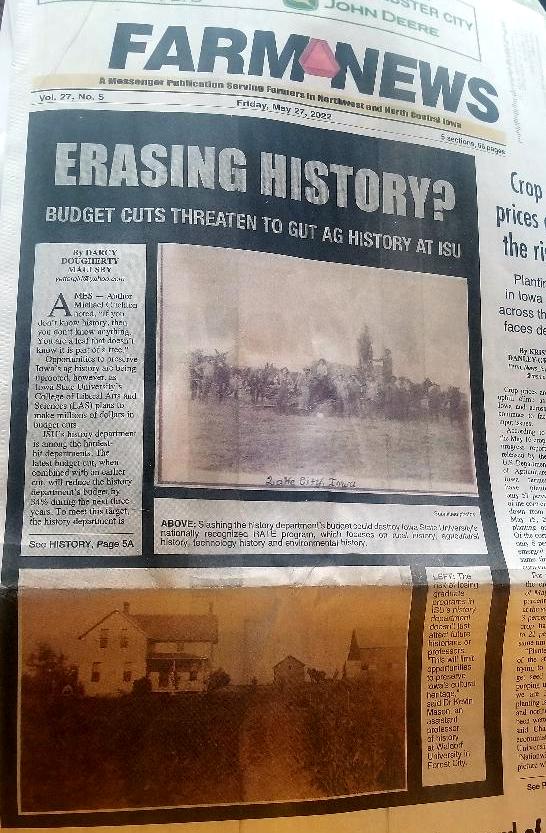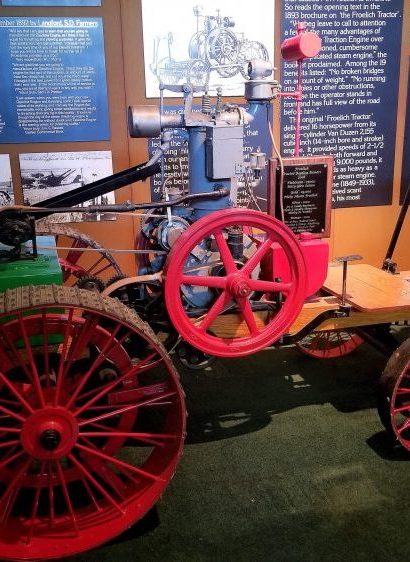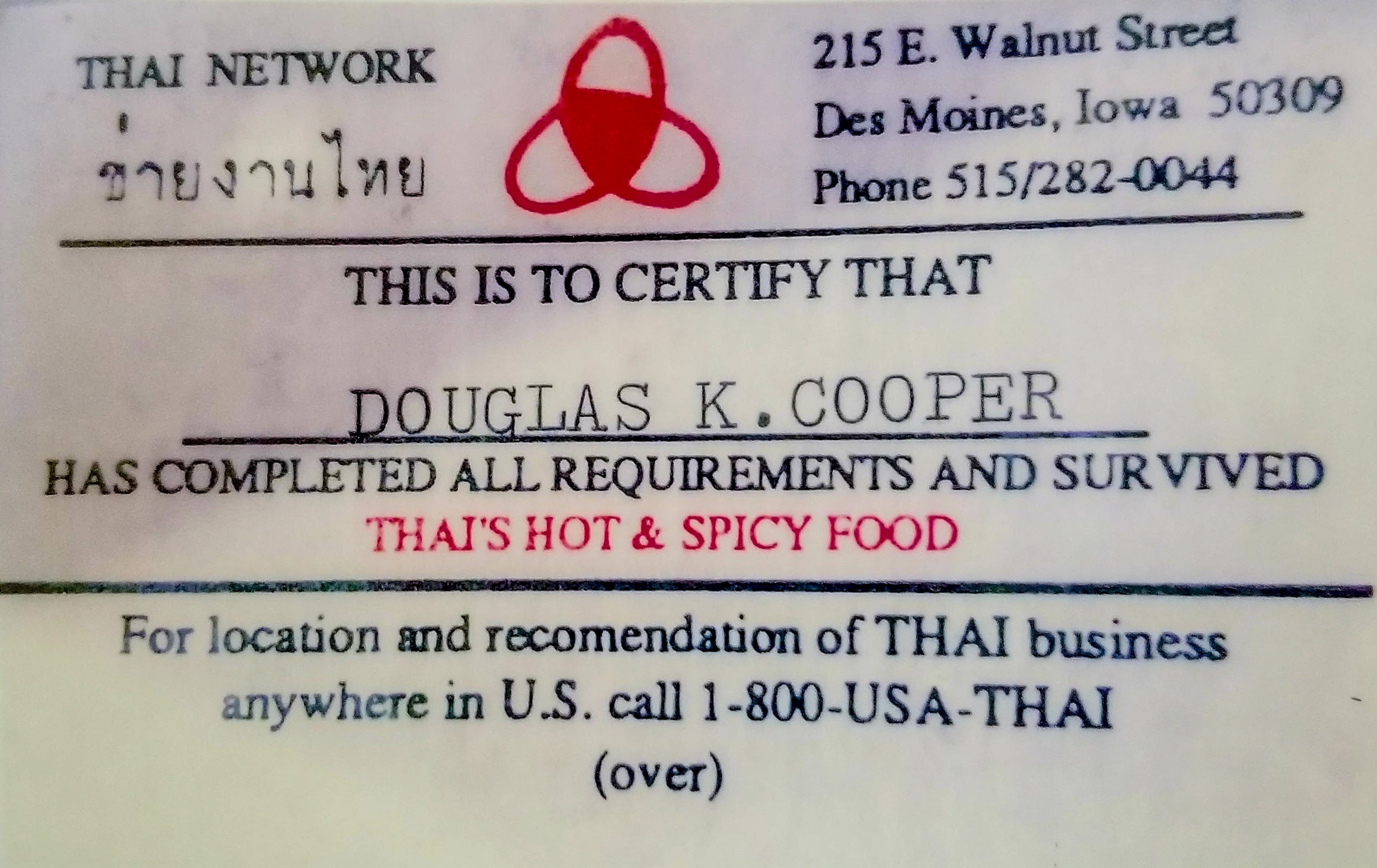
Whats HOT
Latest Posts

How to Tell Your Community’s Story—with Style!
Every community has a wealth of interesting stories to tell. What makes your town unique? More importantly, how can you share those stories to drive tourism, welcome new businesses and residents and put your community on the map in a whole new way?
I call it “story selling,” and it works.
I first discovered the power of a story to inspire action in 1998 when I was a full-time editor at the Iowa Farm Bureau Spokesman. I had the chance to write about something interesting close to my home area of Lake City and Yetter (“Everything’s Better in Yetter”—what a town motto!).
The first thing that popped into my mind? The Jake Burger at the Yetter Café.
Now, granted, this was a tasty, thick, juicy burger, but it’s like a lot of other beef burgers. No secret sauce, wild ingredients or anything like that. What made the story come alive, though, was the restaurant owner.
Merlin “Jake” Janssen is one of those local characters who has done a little bit of everything in his life, from trucking to cooking. When he opened a café in an early 1900s-era two story clapboard home on Plum Street in Yetter, his Yetter Café soon developed a loyal following, from the employees at the ag co-op across the railroad tracks to area farmers to locals who wanted to see what all the fuss was about.
Not one to stick with boring names like “hamburger” or “cheeseburger,” Jake was a marketing wizard of sorts who named his most famous creation the Jake Burger. My story set the stage with all the sensory details, from the cozy feel of the tiny dining room to the savory aroma wafting from the kitchen as Jake fried the burgers. I also shared some of Jake’s backstory along the way, showing what sparked his interest in the restaurant business (I’m a people person!” he exclaimed) and what it’s like to run a café in a town of 35 people.
I described how the Jake Burger came with all the trimmings, from lettuce to tomato to onion. I noted that each culinary creation was prepared by Jake himself. For added spice, I dished about tales of how each Jake Burger was always served with a hearty side of small talk and wise cracks.
After my story and a photo of Jake with his namesake burger ran in the Spokesman, I asked Jake if he got much feedback from that article. “I sure did,” he said. “One guy drove all the way from Nashua to just to try a Jake Burger. Can you believe that?”
To the casual observer, it might seem unbelievable that someone would drive more than 150 miles one way to tiny town to eat a Jake Burger. But that, my friends, is the power of story.
Why does a good story matter?
Imagine a world without stories. If you’re like me, you can listen to a few facts, but not many before you start tuning out. In this hectic, distracted world, true stories well told are incredibly powerful, since they:
- Capture people’s attention
- Propel you past the dreaded “sales pitch syndrome” and invite people to relax and listen
- Put facts in context and make them relevant to your audience
- Convey complex information in a way that’s easy to understand
- Add value
- Build trust
- Boost your competitive advantage
- Showcase the quality of life in your community (arts, entertainment, economic development and more)
- Inspire people to share your content
- Make your community more memorable
- Encourage new businesses to locate in your area
- Attract more grants and investment in your community
- Help existing businesses grow and retain quality employees
- Honor the community’s history
- Enhance community pride
- Attract new residents
- Create momentum that translates into economic development
What makes a good story?
The first step is to identify the people and places that make your community unique. Story ideas might come from the new business that came to town in the last few years, or they might be inspired by the factory that’s been in the community for generations.
Good stories can be found at the local cafe that offers foods inspired by the region, or they can reflect the unique public art project that graces your town square. Compelling stories might include the historic highway that runs through your town and how this influenced the town’s growth, or a great story might focus on a must-see item at the local museum run by dedicated volunteers.
Above all, unforgettable stories revolve around people. Always humanize your stories to help them resonate with your audience.
How do I tell a good story?
Here are some do’s and don’ts:
- Do train your brain to always be looking for potential stories you can share.
- Don’t just rattle off lists of facts or opinions (our town has 2,500 people, we have 20 businesses in town, we are a progressive community, etc.). This information is important, but it’s not a story.
- Do learn what defines a story. Some of the best stories take a problem/solution format, almost like a case study. In my hometown of Lake City, Iowa, I think of Opportunity Living, a home for handicapped people. In a nutshell, the story is a classic problem/solution story that goes like this:
- “For generations, Lake City, Iowa, was a vibrant rural community and economic hub, but the 1980s Farm Crisis devastated the local area and led to the demise of many long-time businesses like Snyder Implement. Community leaders knew something needed to change, so they envisioned new possibilities for the large, vacant implement business on the east edge of town. Through their hard work, Opportunity Living took shape in the late 1980s and early 1990s and now provides homes throughout Lake City and Rockwell City for people with special needs. This dynamic organization also provides many jobs for local people and helps enhance the quality of life in the community.”
- Do use stories to show how people of all ages are making a positive difference in your community.
- Don’t forget to find partners throughout the community who can help you identify and share stories. Partner with the school, local businesses, volunteers, civic groups, church groups and others.
- Do choose your words carefully. Community leaders in Jefferson, Iowa, for example, doesn’t refer to vacant buildings as “empty buildings.” They call them “available buildings.”
How can I use my story to promote my community?
Here are some stories I’ve written about local entrepreneurs and tourism destinations:
Events Spark Stories That Help Backcountry Winery Grow in Iowa
Young Entrepreneur Grows a Healthy Business in Small-Town Iowa
Digging Deeper: Volunteers Showcase Thomas Jefferson Gardens
People are listening!
I received this wonderful note from Mary Weaver after I wrote the story about the Thomas Jefferson Gardens:
“On a very pleasant note, we are getting visitors because of the articles. We have, that we are aware of, three different sets of visitors from Humboldt. It is the type of visitor story we will tell the City Council when we report to them in September.
The best anecdote was a woman who was part of an assisted living bus tour that was coming to Jefferson from Humboldt, but the destination was the casino. She persuaded the driver her to bring her to TJG rather than the casino and she stayed the entire length of time the others were gambling.
The second was a couple I met yesterday during Tuesday Talks. It was their second visit for a “Tuesday Talk,” they ate at a local restaurant, went shopping at the quilt and antique store.
Certainly is the type of economic/tourism development we have been hoping to create. Thank you Darcy for your splendid articles about the Thomas Jefferson Gardens”
How can I use my story over and over?
Repurposing your stories is one of the smartest marketing moves you can make. Stories can take many forms, including blog posts, press releases, newspaper or magazine articles, videos, social media posts (for mini stories or links to your stories online), podcasts, speeches, photographs, advertisements and more. The key is to meet your audience where they’re at and use various marketing channels to spread the word.
Remember, if you don’t tell your story, who will? It’s a fun journey, and you stand so much to gain.
What if I don’t know where to start, or I just don’t have enough time to write my community’s stories?
If your budget allows, you might want to hire a professional storyteller. I understand the power of storytelling, because I’ve lived it and use it to grow my own business. As a trained journalist, book author, business owner, entrepreneur, marketer, historian and farmer, I offer you a writer’s skill, a storyteller’s artistry, an entrepreneur’s insight, a historian’s knowledge, and a farmer’s practicality.
My formal education includes bachelor’s degrees in journalism/mass communication and history from Iowa State University (ISU), along with a master’s degree in business administration (MBA) with an emphasis in marketing from ISU, but that’s just part of the story.
I also bring 20+ years of professional storytelling, writing and marketing experience and have served clients of all sizes, from local mom-and-pop businesses to multi-national corporations like Syngenta, help share their stories. I’m “bilingual” in terms of my ability to speak your language and the language that resonates with your clients and prospects.
When I started my writing/marketing business (Darcy Maulsby & Co.) in 2002, I learned the hard way that I can’t be everything to everybody. I’m not an expert in video production. I don’t like managing other people’s social media pages. I do specialize in storytelling, though, and am ready to put this powerful marketing tool to work for you.
I look forward to visiting with you to find out what makes your organization tick. Let’s discover those specific details and pivotal moments that make your stories relevant, relatable and unforgettable. Then I’ll show you how we can shape this raw material into stories that speak to the hearts and minds of your audience.
I invite you to connect with me at www.darcycmaulsby.com and on social media (I’m on Facebook, Twitter and Instagram). I look forward to staying in touch.
Want more?
Thanks for stopping by. I invite you to read more of my blog posts if you value intriguing Iowa stories and history, along with Iowa food, agriculture updates, recipes and tips to make you a better communicator.
If you like what you see and want to be notified when I post new stories, be sure to click on the “subscribe to blog updates/newsletter” button at the top of this page, or click here. Feel free to share this with friends and colleagues who might be interested, too.
Also, if you or someone you know could use my writing services (I’m not only Iowa’s storyteller, but a professionally-trained journalist with 20 years of experience), let’s talk. I work with businesses and organizations within Iowa and across the country to unleash the power of great storytelling to define their brand and connect with their audience through clear, compelling blog posts, articles, news releases, feature stories, newsletter articles, social media, video scripts, and photography. Learn more at www.darcymaulsby.com, or e-mail me at yettergirl@yahoo.com.
If you’re hungry for more stories of Iowa history, check out my top-selling “Culinary History of Iowa: Sweet Corn, Pork Tenderloins, Maid-Rites and More” book from The History Press. Also take a look at my latest book, “Dallas County,” and my Calhoun County” book from Arcadia Publishing. Both are filled with vintage photos and compelling stories that showcase he history of small-town and rural Iowa. Order your signed copies today! Iowa postcards are available in my online store, too.
Let’s stay in touch. I’m at darcy@darcymaulsby.com, and yettergirl@yahoo.com.
Talk to you soon!
Darcy
@Copyright 2018 Darcy Maulsby & Co. Blog posts may only be reprinted with permission from Darcy Maulsby.
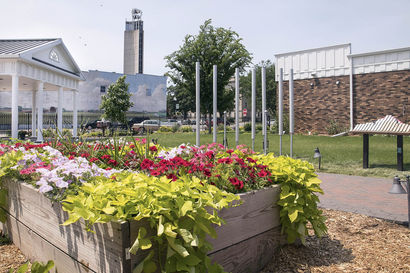
Digging Deeper: Volunteers Showcase Thomas Jefferson Gardens in Iowa
What comes to mind with the name Thomas Jefferson? President, perhaps? Avid agriculturist and gardener also fit, especially in Jefferson, where locals are quick to share this rich history.
“Cultivators of the earth are the most valuable citizens,” Jefferson wrote in 1785 to John Jay, a fellow founder of the United States and first chief justice of the United States. “They are the most vigorous, the most independent, the most virtuous, and they are tied to their country and wedded to its liberty and interests by the most lasting bonds.”
Jefferson frequently extolled the virtues of the agrarian life and championed self-government. His legacy and ideals are honored on in the Thomas Jefferson Gardens of Greene County, Iowa (TJGGCI), in downtown Jefferson, thanks to dedicated volunteers, local civic groups and other community-minded supporters.
A life-sized statue of Jefferson himself greets visitors to the gardens, which surround the local Welcome Center/chamber of commerce office southeast of the Greene County courthouse. “The statue is so lifelike that I think a person is sitting there when I catch a glimpse of it while I’m working,” said Jean Walker, head gardener and secretary of the TJGGCI.
Jefferson’s interest in agriculture blends seamlessly with a rural community like Jefferson that honors its ag heritage and looks for new ways to promote the area, said John Turpin, a retired social studies teacher and coach from Jefferson who serves as treasurer and historian for the TJGGCI. “Jefferson was a student of the flora and fauna in his home state of Virginia. He also thought agriculture was the most important career a person could have.”
Making something out of nothing
So what came first in Jefferson—the statue or the garden? It all started in 2010 when Wallace Teagarden, a Greene County native, lawyer and long-time admirer of Jefferson’s philosophies, wanted to combine his love of agriculture and Greene County in a lasting legacy to the author of the Declaration of Independence.
Teagarden commissioned Jon Hair, an Iowa native and world-renowned sculptor, to create a statue of Jefferson. While displaying the statue on the courthouse lawn was the original idea, it was decided that the statute should become focal point of the new TJGGCI, located just down the street to the east of the iconic Mahanay Bell Tower.
A great deal of work went into creating the nearly $1 million gardens that visitors enjoy today. “This lot where the gardens are had three dilapidated old buildings on it that had to be removed,” said Mary Weaver, who leads 12-member volunteer board of the TJGGCI.
The ground itself wasn’t ideal, either. Old cans and other debris were buried in the corner behind the area where a filling station once stood on the property. “Multiple truckloads of soil were hauled in here,” Walker said.
Before some of the first plants could even be planted, grant writing and fundraising were essential. Project leaders received grants from Vision Iowa and Grow Greene County, along with support from Alliant Energy, West Central Cooperative (which is now Landus Cooperative, the Greene County Board of Supervisors, and countless other groups and individuals.
By 2014, the first plants were added to the new garden. Today, brick paving connects the five distinct gardens in the TJGGCI, including:
• The farmer’s garden on the east. Volunteers have grown broom corn, white corn, pumpkins, squash, Yukon Gold potatoes, flax and more in this garden, which is near a replica of Jefferson’s “mouldboard of least resistance” for a plow. While serving as minister to France, Jefferson had the opportunity to observe European plow designs. Their deficiencies inspired him to design an improved moldboard (the part of the plow that lifts up and turns over the sod cut by the plow share). He wished to make that lifting and turning action as efficient as possible so the plow could be pulled through the soil with the least expenditure of force. He never sought to patent his design and sent numerous models to friends at home and abroad, where his design met with general approval.
• A prairie garden on the north, filled with native plants. “This is what Lewis and Clark would have seen when they explored Iowa following the Louisiana Purchase,” Turpin said.
• A children’s garden, with beds made from old wagon wheels. This fun garden showcases unique plants like the sensitive plant, whose leaves and stems curl up when touched.
• A flower and rose garden on the west. This garden is filled with 1,000 plants, including many perennials ranging from irises to daylilies. This garden also includes Buck roses, which are hardy varieties developed by Dr. Griffith Buck from Iowa State University. In addition, some of the plants in the garden have been donated from local gardens, including two peony plants that are more than 100 years old, Walker said. Those are located near the garden’s striking pavilion, a Federal design reminiscent of architectural styles associated with Jefferson. Even the little free library in the garden near the pavilion reflects Jefferson’s legacy, since it’s designed to look like Monticello, Jefferson’s estate in Virginia.
• Five raised garden beds on the south. Grapevines grow on a cedar trellis just to the south of the raised beds. The raised beds are used to grow various vegetables that are donated to the local food pantry and congregate meal program. “The first year we planted crops like parsnips, turnips and kohlrabi that Jefferson planted in his own gardens,” Walker said. “Those didn’t prove very popular here, though, so we grow peppers, heirloom tomatoes, peas, green beans and more.”
Learning and growing
Since Thomas Jefferson was interested in music as well as agriculture, the TJGGCI project leaders added whimsical, larger-than-life musical instruments, including a contra base chime and xylophone, to bring sound to the garden.
“We were inspired by the outdoor instruments at Okoboji in the Arnolds Park area,” said Jacque Andrew of Jefferson, who handles marketing for the TJGGCI. “Anyone can play these instruments, and they make the garden more interactive.”
So far, there has been one wedding in the garden in 2016. Tour groups from Des Moines to South Dakota have also visited the gardens.
Volunteers continue to work to make the garden even more inviting. They hope to add a third musical instrument and are hosting another year of Tuesday Talks. These free, educational lectures are held in the garden each Tuesday from noon until 1 p.m. through mid[August. Topics range from perennial gardening to birds in the garden. “A garden is always a work in progress,” Walker said.
That’s part of what brings people together and makes this project inspiring, Weaver added. “These gardens make me so proud of the community. We want to help Jefferson and Greene County become a destination, and the gardens are an important part of this.”
People are listening
P.S. I received this wonderful note from Mary Weaver after this article I wrote ran in Farm News in July 2018:
“On a very pleasant note, we are getting visitors because of the articles. We have, that we are aware of, three different sets of visitors from Humboldt. It is the type of visitor story we will tell the City Council when we report to them in September.
The best anecdote was a woman who was part of an assisted living bus tour that was coming to Jefferson from Humboldt, but the destination was the casino. She persuaded the driver her to bring her to TJG rather than the casino and she stayed the entire length of time the others were gambling.
The second was a couple I met yesterday during Tuesday Talks. It was their second visit for a “Tuesday Talk,” they ate at a local restaurant, went shopping at the quilt and antique store.
Certainly is the type of economic/tourism development we have been hoping to create. Thank you Darcy for your splendid articles about the Thomas Jefferson Gardens.”
Want more?
Thanks for stopping by. I invite you to read more of my blog posts if you value intriguing Iowa stories and history, along with Iowa food, agriculture updates, recipes and tips to make you a better communicator.
If you like what you see and want to be notified when I post new stories, be sure to click on the “subscribe to blog updates/newsletter” button at the top of this page, or click here. Feel free to share this with friends and colleagues who might be interested, too.
Also, if you or someone you know could use my writing services (I’m not only Iowa’s storyteller, but a professionally-trained journalist with 20 years of experience), let’s talk. I work with businesses and organizations within Iowa and across the country to unleash the power of great storytelling to define their brand and connect with their audience through clear, compelling blog posts, articles, news releases, feature stories, newsletter articles, social media, video scripts, and photography. Learn more at www.darcymaulsby.com, or e-mail me at yettergirl@yahoo.com.
If you’re hungry for more stories of Iowa history, check out my top-selling “Culinary History of Iowa: Sweet Corn, Pork Tenderloins, Maid-Rites and More” book from The History Press. Also take a look at my latest book, “Dallas County,” and my Calhoun County” book from Arcadia Publishing. Both are filled with vintage photos and compelling stories that showcase he history of small-town and rural Iowa. Order your signed copies today! Iowa postcards are available in my online store, too.
Let’s stay in touch. I’m at darcy@darcymaulsby.com, and yettergirl@yahoo.com.
Talk to you soon!
Darcy
@Copyright 2018 Darcy Maulsby & Co. Blog posts may only be reprinted with permission from Darcy Maulsby.
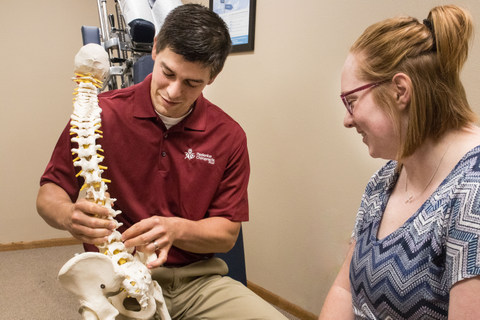
Young Entrepreneur Grows a Healthy Business in Small-Town Iowa
It’s no secret that rural Iowa has suffered through decades of population loss. The current trends are sobering, when you see data from the U.S. Census Bureau showing that two-thirds of Iowa counties (that’s 71 counties, including my home county of Calhoun County in west-central Iowa) lost population between 2010 and 2017, while 28 saw gains. So what would attract a young entrepreneur to an area like Calhoun County?
It’s a question I asked Dr. Jeff Redenius, who opened Redenius Chiropractic, PLC, in my hometown of Lake City (population 1,700) in 2016. Not only has this native son grown his customer base at his thriving chiropractic clinic, which is housed in the former variety store on Main Street, but perhaps the biggest surprise of all is the popularity of his attached 24-hour fitness center. So what’s the secret of this dynamic entrepreneur’s success? Here’s his story, which I shared in the 2018 Hometown Pride section of the Fort Dodge Messenger.
Back to Health:
Dr. Jeff Redenius Promotes Fitness, Wellness for All Ages
Jeff Redenius had enough to worry about as final exams loomed during his senior year at Central College in Pella. As he studied for his tests, however, the Lake City native suddenly felt like a knife was plunging into his chest.
“It was so intense I couldn’t take a deep breath,” said Redenius, 28, who owns Redenius Chiropractic, PLC, and a 24-hour fitness center in Lake City. “I went to a chiropractor and found out I had a rib out of place.”
A quick adjustment provided effective relief. Redenius learned that displaced ribs are fairly common and can be triggered by stress. “I typically see at least one patient each day with a displaced rib,” said Redenius, who opened his chiropractic clinic along Main Street in Lake City in August 2016.
Redenius’s own ordeal with pain prompted him to pursue a career in chiropractic care. “I was amazed at how much relief I experienced by going to the chiropractor,” he said. “I had known since high school that I wanted to go into health care, but this experience helped me clarify which area of health care to specialize in.”
Becoming a business owner
Redenius first discovered the value of high-quality health care close to home when he tore the anterior cruciate ligament (ACL) in his knee while playing football during his junior year of high school.
“I went to the hospital for physical therapy and began to appreciate all the medical care we have right here in Lake City,” said Redenius, who graduated from Southern Cal High School in Lake City in 2008.
After earning his bachelor of science degree in athletic training from Central College in in 2012, he wasn’t sure whether he wanted to pursue an advanced degree in physical therapy or chiropractic care. His displaced rib during final exams, along with his desire to own his own business, prompted his decision to enroll at the Palmer College of Chiropractic in Davenport.
“My dad, Gary, is a carpenter and has run his business for years, and I wanted to follow in his footsteps,” added Redenius, who had often worked with his father on construction projects through the years.

During Redenius’s years at Palmer, he served as the head athletic trainer and worked with the Palmer men’s and women’s rugby teams. After graduating from Palmer in February 2016, he and his wife, Jenny, a Hudson, Iowa, native, assessed their options about their next career moves.
The couple considered moving to Waverly, since it’s a growing community and a college town, but it proved more affordable for Redenius to open his chiropractic clinic in his hometown, especially when the local dime store on Main Street came up for sale.
“I knew a lot of people around here, which I figured would help grow my business faster,” Redenius said. “We also like the affordable cost of living and the chance to be close to family and raise our son, Sam, here.”
Fitness center proves popular
With approximately 5,500 square feet in the former dime store, the spacious building offered room for more than just a chiropractic clinic with exam rooms, a therapy room and an x-ray room. When Jenny suggested adding a fitness center, Redenius didn’t think it was feasible. “It was a great idea, but I was so overwhelmed by opening the chiropractic clinic that I didn’t think I could take on another project.”
Then Redenius found out that the Palmer College of Chiropractic was building a new fitness center and was willing to sell all the equipment from the former fitness center, including the free weights, the cable machines and the elliptical trainers, for a great deal. He rounded up some strong helpers, lined up a semi-truck and moved all the gym equipment to his building in Lake City.
After some remodeling, Redenius’s new 24-hour fitness center was ready for business. “We opened the fitness center in June 2016, a few months before I opened my chiropractic clinic in August that year,” Redenius said.
Some fitness center members like to take exercise classes and work with a personal trainer, while others like Mary Fern like to design their own workout routine. “I come here five to six days a week,” said Fern, 91, who moved to Lake City in August 2017. “It’s convenient, plus I like the variety.”
Fern walks laps in the gym, uses the cable machine to strengthen her arms and works out on the NuStep, which looks similar to an exercise bike and offers a safe, low-impact way to get a total-body workout. “Why do I exercise? If you don’t use it, you lose it,” she said.
Fern is a walking example of the power of healthy living, said Redenius, who features a quote from Thomas Edison on the wall of his reception area. “The doctor of the future will give no medication but will interest his patients in the care of the human frame, diet and in the cause and prevention of disease.”
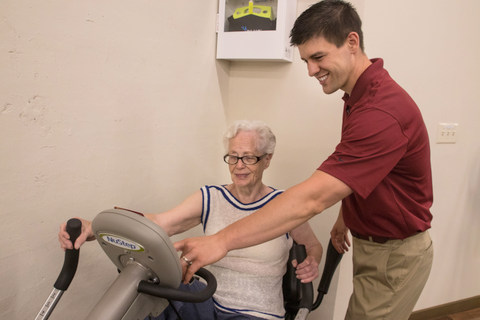
Dr. Jeff Redenius promotes fitness for all ages. Mary Fern is 91 years young and follows a “use it or lose it” exercise and wellness philosophy.
“We’ve only started to make our mark”
While fitness and chiropractic care go hand in hand, along with massage therapy services provided at Redenius Chiropractic by therapist Haley Abbott, Redenius doesn’t hesitate to refer patients to other health-care providers, when necessary.
Redenius is also seeking new ways to promote healthy living, including a new weight-loss program he began offering this summer. The four-stage program includes a meal plan and weekly coaching to help patients reach a healthier weight. “You only have one body, and I’m more about preventing disease than fixing problems.”
That spirit of service also extends to Redenius’s hobbies and work in the community. In 2017, he purchased the Baptist Church complex in Lake City after the congregation joined with the Woodlawn Christian Church in Lake City. He has been remodeling the education wing into two apartments. One unit has been rented, and the other is available for rent.
“I like to build things and create positive change, from people’s health to my business to the local community,” Redenius said. “We’ve only started to make our mark.”
Want more?
Thanks for stopping by. I invite you to read more of my blog posts if you value intriguing Iowa stories and history, along with Iowa food, agriculture updates, recipes and tips to make you a better communicator.
If you like what you see and want to be notified when I post new stories, be sure to click on the “subscribe to blog updates/newsletter” button at the top of this page, or click here. Feel free to share this with friends and colleagues who might be interested, too.
Also, if you or someone you know could use my writing services (I’m not only Iowa’s storyteller, but a professionally-trained journalist with 20 years of experience), let’s talk. I work with businesses and organizations within Iowa and across the country to unleash the power of great storytelling to define their brand and connect with their audience through clear, compelling blog posts, articles, news releases, feature stories, newsletter articles, social media, video scripts, and photography. Learn more at www.darcymaulsby.com, or e-mail me at yettergirl@yahoo.com.
If you’re hungry for more stories of Iowa history, check out my top-selling “Culinary History of Iowa: Sweet Corn, Pork Tenderloins, Maid-Rites and More” book from The History Press. Also take a look at my latest book, “Dallas County,” and my Calhoun County” book from Arcadia Publishing. Both are filled with vintage photos and compelling stories that showcase he history of small-town and rural Iowa. Order your signed copies today! Iowa postcards are available in my online store, too.
Let’s stay in touch. I’m at darcy@darcymaulsby.com, and yettergirl@yahoo.com.
Talk to you soon!
Darcy
@Copyright 2018 Darcy Maulsby & Co. Blog posts may only be reprinted with permission from Darcy Maulsby.
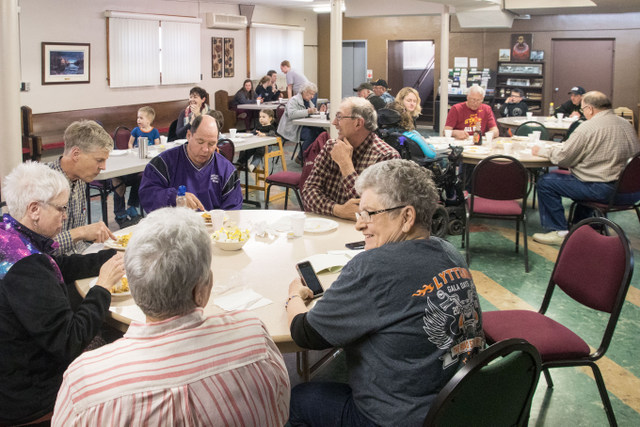
Doing Good, Eating Good at Lytton Town Night
What’s the glue that keeps a community connected? Around Lytton, Iowa, it’s food and fun at Lytton Town Night–and the homemade pie, of course.
While Lytton, Iowa, celebrates Gala Days each year during Memorial Day weekend, planning and fundraising for this beloved 100+ year tradition starts months earlier. In fact, a key part of the process starts in that most iconic of all small-town gathering places—the church basement.
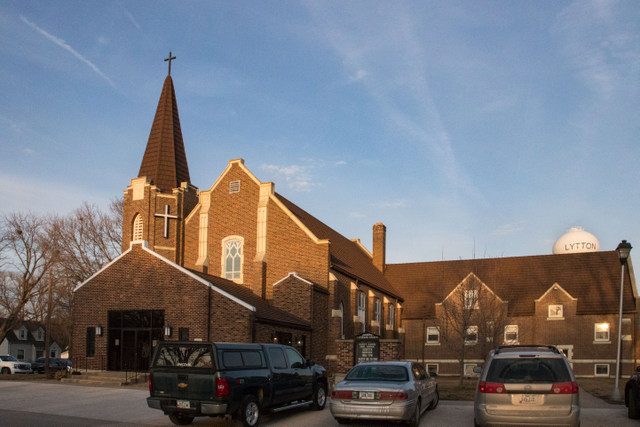
Emanuel-St John Lutheran Church in Lytton, Iowa, hosts Lytton Town Night meals throughout the winter.
The basement dining area at Emanuel-St John Lutheran Church, whose congregation has roots dating back to 1883, provides a convenient setting for Lytton Town Night, which is held each Thursday evening from mid-January through March. Each Town Night offers a unique opportunity for the community to come together for free-will-donation meal to raise money for various causes and organizations, including Gala Days.
“Town Night is great, because there are a lot of fabulous cooks around Lytton,” said Nelda Bartels, a lifelong Lytton-area resident who often volunteers at Town Night.
As word of Town Night has spread through the years, guests come not only from Lytton, but Lake City, Sac City, Rockwell City and beyond. It’s not uncommon to serve a few hundred people at each meal.
“It’s like one big family when everyone gets together,” said Wendy Miller with the Lytton Chamber of Commerce.
Lytton Town Night includes groups like the Gala Days volunteers, the South Central Calhoun FFA chapter, 4-H clubs, civic groups and individuals raising money for worthy causes, including overseas mission trips. The Lytton Chamber of Commerce coordinates the schedule for Town Night, which allows eight to 10 different groups and individuals to host a Town Night meal during the winter, complete with home-cooked food. Some groups serve a selection of pasta casseroles, while others like the local FFA members serve pancakes and sausage links.
“I like the food, because it’s all good,” said Randy Souder, a Lytton-area farmer. “It’s also affordable, so everyone can come.”
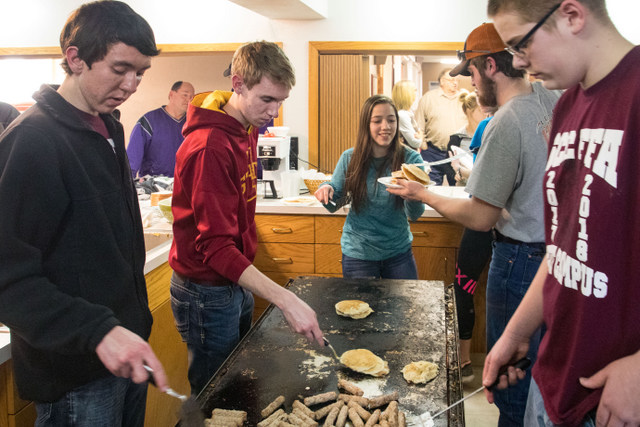
Members of the South Central Calhoun FFA chapter cooked pancakes and sausage during a Lytton Town Night fundraiser.
While no one is quite sure when Lytton Town Night started, it has been around since at least 1980, according to local-time residents. “It’s such a fun event, because you get to visit with friends and neighbors you don’t always see,” said Marlene Glasnapp, who lives with her husband, Roger, on a farm south of Lytton and is known as one of the best pie bakers in the area.
Each Town Night event is promoted through the Lytton Town Crier and on social media through Facebook. Each meal runs from 5 p.m. to 7 p.m. each Thursday evening during the winter. The popular gatherings attract people of all ages, from babies to grandparents.
Some groups, like the Gala Days volunteers, serve a lunch and a dinner meal when it’s their turn to host Town Night. “We usually have casseroles and homemade pie,” Bartels said. “The homemade pie is the kicker, because it’s always a hit.”
When the meal is done, the fellowship continues in downtown Lytton at the 1950s-era American Legion hall for bingo. “Town Night bingo has been called Lytton’s winter sport,” Bartels said.
The evening of bingo lasts about an hour and a half, and participants can play as many cards as they want. Two cards cost $3, and the proceeds support the American Legion.
Town Night isn’t just a fun evening, added Brian Lantz, an ag instructor at South Central Calhoun High School who advises the local FFA chapter. “It’s a local tradition, plus the kids learn how to work with the public when it’s their turn to cook and serve the meal.”
Keeping the Town Night tradition alive is important to residents of Lytton, which has a population of 302 residents. “Every year we wonder if we’ll be able have Town Night again,” Miller said. “We’re going to keep it going as a long as we can.”

Creamy Chicken Pasta Casserole
Creamy Chicken Casserole
This simple, hearty dish from Nelda Bartels of Lytton was served at the Gala Days fundraiser at Lytton Town Night in March 2018.
3 boneless, skinless chicken breasts, cooked and shredded
1 teaspoon garlic powder
1 tablespoon olive oil
1 10.75-ounce can cream of chicken soup
1 10.75-ounce can cream of mushroom soup
1 cup milk
1 bag (2 cups) shredded Cheddar cheese
1 / 2 teaspoon ground black pepper
1-pound box elbow macaroni (cooked according to package directions)
1 1 / 2 cups panko bread crumbs or regular bread crumbs
Preheat oven to 350 degrees. Cook chicken with garlic powder. (Nelda uses a programmable pressure cooker and adds a couple cups of chicken broth.) Drizzle with olive oil. When done, shred chicken with a fork, and save the juice.
Combine the two cream soups, milk, cheese, cooked chicken, broth from chicken and pepper. (If desired, add some sour cream or cream cheese into the mixture for extra flavor and creaminess.) Add cooked macaroni. Stir the mixture and pour into a 9-inch by 13-inch casserole pan.
Top casserole with panko breadcrumbs. Bake at 350 degrees for 20 to 25 minutes. Brown panko topping under broiler on low for 3 to 5 minutes. Watch closely, since the breadcrumbs can burn quickly.
Bowtie Lasagna Casserole
This tasty recipe comes from Nelda Bartels of Lytton.
1 jar spaghetti sauce
1 to 1.5 pounds ground beef
1 package bowtie pasta noodles (cooked according to package directions)
1 small carton cottage cheese
1 8-ounce package cream cheese
1 small carton sour cream
Mozzarella cheese
Preheat oven to 350 degrees. Brown hamburger; mix with spaghetti sauce. Pour sauce on bottom of 9-inch by 13-inch baking pan. Combine hamburger and bowtie pasta. Combine cottage cheese, cream cheese, and sour cream. Add to hamburger/pasta mix; pour in baking pan. Top with mozzarella cheese.
Bake at 350 degrees for 45 minutes to 1 hour.
Poppy Seed Chicken
This recipe comes from Susan Albright of Lytton.
4 chicken breasts, cooked and cubed
1 carton (16 ounces) sour cream
1 10.75-ounce can cream of chicken soup
Very small handful of spaghetti, broken into pieces and cooked (Susan Albright uses three fourths of a box of angel hair pasta)
1 stick butter
40 Ritz crackers, crushed
1 / 2 tablespoon poppy seeds
Preheat oven to 350 degrees. After cooking chicken, season to taste with garlic salt and onion. Combine sour cream and soup. Add cubed chicken and cooked spaghetti to mixture. Add salt, to taste.
Pour mixture into greased, 9-inch by 13-inch baking dish.
In a separate bowl, melt butter; add crushed crackers and poppy seeds. Sprinkle cracker mixture on top of casserole. Bake for 20 minutes.
Pie Crust
For decades, Marlene Glasnapp of rural Lytton has relied on this recipe, which yields approximately 6 crusts per batch.
5 cups flour
1 teaspoon salt
1 pound lard
1 cup water
Combine flour and salt. Cut lard into the flour mixture. Add water, a little at a time, mixing quickly and evenly until dough just holds together in a ball. Divide dough for six crusts. (The crusts can be frozen for later use, and Marlene often rolls hers out before freezing.)
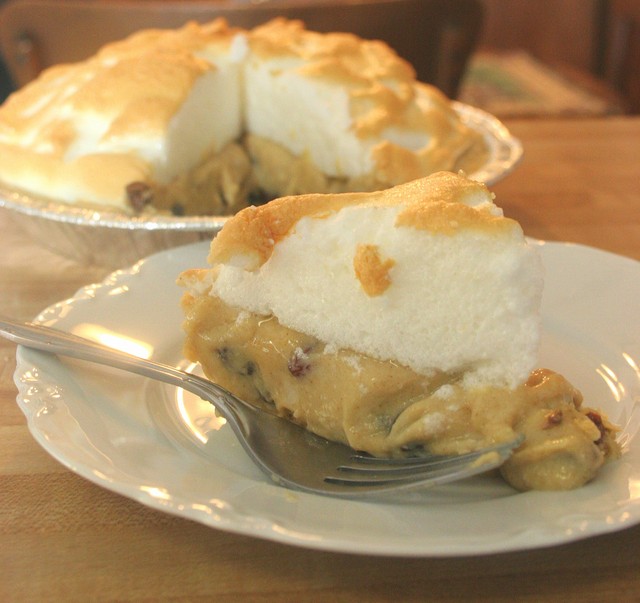
Raisin Cream Pie
Marlene Glasnapp’s raisin cream pie is always a hit wherever it’s served.
1 cup granulated sugar
3 tablespoons flour
1 / 2 teaspoon salt
1 teaspoon cinnamon
2 cups half-and-half
3-4 egg yolks (depends on the size of the eggs)
1 cup raisins
Mix dry ingredients with 1 / 2 cup of half-and-half, and set aside. Whisk egg yolks, and combine remaining half-and-half with the yolks. Add this mixture to the pie filling mix you set aside earlier.
Add raisins to the mixture and stir over medium heat until thick. Cool slightly. Pour in baked pie shell and top with meringue.
Meringue
1 tablespoon cornstarch
1 / 2 cup plus 1 tablespoon water
3 to 4 egg whites (depending on the size of the eggs)
3 to 4 tablespoons granulated sugar
Dissolve 1 tablespoon of cornstarch in 1 tablespoon of water. Boil 1 / 2 cup water and add to cornstarch mixture. Cook until clear. (This can be done in the microwave.) Beat egg whites and gradually add sugar. Add cooled cornstarch mixture and beat to proper consistency. Spread meringue over top of pie, sealing to the edge. Bake pie at 350 degrees Fahrenheit until meringue has browned.
Note from Darcy: I first wrote this piece in 2018 for Farm News.
Want more?
Thanks for stopping by. I invite you to read more of my blog posts if you value intriguing Iowa stories and history, along with Iowa food, agriculture updates, recipes and tips to make you a better communicator.
If you like what you see and want to be notified when I post new stories, be sure to click on the “subscribe to blog updates/newsletter” button at the top of this page, or click here. Feel free to share this with friends and colleagues who might be interested, too.
Also, if you or someone you know could use my writing services (I’m not only Iowa’s storyteller, but a professionally-trained journalist with 20 years of experience), let’s talk. I work with businesses and organizations within Iowa and across the country to unleash the power of great storytelling to define their brand and connect with their audience through clear, compelling blog posts, articles, news releases, feature stories, newsletter articles, social media, video scripts, and photography. Learn more at www.darcymaulsby.com, or e-mail me at yettergirl@yahoo.com.
If you’re hungry for more stories of Iowa history, check out my top-selling “Culinary History of Iowa: Sweet Corn, Pork Tenderloins, Maid-Rites and More” book from The History Press. Also take a look at my latest book, “Dallas County,” and my Calhoun County” book from Arcadia Publishing. Both are filled with vintage photos and compelling stories that showcase he history of small-town and rural Iowa. Order your signed copies today! Iowa postcards are available in my online store, too.
Let’s stay in touch. I’m at darcy@darcymaulsby.com, and yettergirl@yahoo.com.
Talk to you soon!
Darcy
@Copyright 2018 Darcy Maulsby & Co. Blog posts may only be reprinted with permission from Darcy Maulsby.
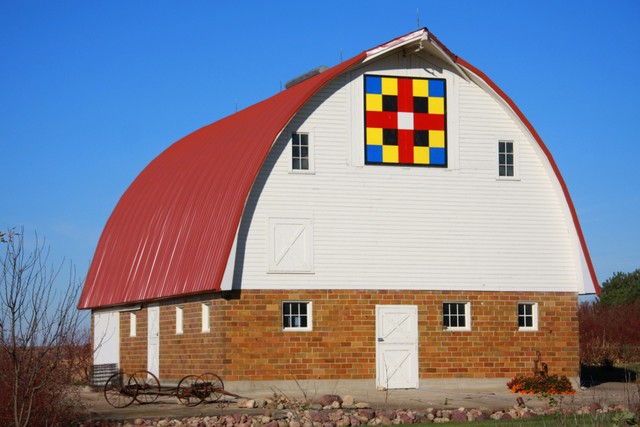
Sac County Barn Quilt Attracts National Attention
When Alvin (Al) Liske and his wife, Jean, signed up for the Barn Quilts of Sac County project, they had no idea how much attention this would attract to their stately World War II-era barn west of Early, Iowa.
“Our barn has been featured in Eleanor Burns’ book, ‘Quilt Blocks on American Barns,’ and it was also included on the cover of the Department of Transportation’s 2009 map of Iowa,” said Jean.
Burns, a popular television personality who gained famed for her “Quilt in a Day” system, visited the Liske barn last year when she traveled to Iowa to participate in the Sac County Quilt-a-Fair. She was especially intrigued by the Country Lanes barn quilt pattern that graces the barn’s haymow door. She noted that Country Lanes is a very old pattern that was originally published by Mountain Mist, a company that began selling quilt batting in Cincinnati in 1846.
“We chose the Country Lanes block, because we live on a gravel road,” said Jean, who works in the registrar’s office at Buena Vista University in Storm Lake. “Even though we’re off the beaten path, it’s not uncommon to see people drive out here and take photos of the barn.”
Jean’s father, Herman Puetz, built the barn for approximately $4,000 around 1943 or 1944 on the Boyer Valley Township farm that his family had purchased in 1930. The new barn replaced an existing barn that was made from cottonwood lumber. After the concrete foundation for the new barn was poured, lumber was not readily available for the building, due to the war. In the meantime, the family roller skated on the concrete slab. “When construction started again, I can also remember going with my parents to Albert Lea, Minn., to get the rafters for the barn, and I thought that was a really long trip,” said Jean, who noted that the barn includes glazed tile on the bottom and originally had wood shingles on the rounded, gothic roof.
Herman kept horses in the barn, said Jean, who added that farming with horses could be dangerous. “One time when my Uncle George was hauling manure on our farm, something spooked the horses, and they ran toward a barbed wire fence. My uncle jumped off, and he broke his ankle, which got infected.”
Jean’s father, who was one of 12 children, also milked cows on the east side of the barn and kept plenty of hay in the haymow. “I’d play in the barn with my brothers and sister, and we’d make tunnels and caves and houses with the bales. When enough hay had been fed, there would be bare spots in the haymow, and we’d play basketball up there,” said Jean, who noted that the haymow still includes basketball hoops.
After Jean married Al and the couple moved to the farm where Jean grew up, the Liskes raised cattle and hogs in the barn and farmed from the early 1960s until the 1980s. In 2005, the couple decided to remodel the barn, which still had a good foundation. “It was getting to the point where we needed to fix up the barn or think about tearing it down, and we didn’t want to watch the barn fall down,” said Jean, who noted that the family power washed the interior, rebuilt windows and doors, had the barn rewired, covered the roof with red steel and added a staircase to the haymow.
The barn, which is now used for storage, became
a favorite play area for the Liske’s grandchildren. “The barn is an important part of our family’s heritage, and it’s one of the few old buildings left on this farm,” Jean said. “My dad was always proud of the barn, and we’re glad we’ve maintained it.”
Note from Darcy: I first wrote this piece in 2010 for Farm News.
Want more?
Thanks for stopping by. I invite you to read more of my blog posts if you value intriguing Iowa stories and history, along with Iowa food, agriculture updates, recipes and tips to make you a better communicator.
If you like what you see and want to be notified when I post new stories, be sure to click on the “subscribe to blog updates/newsletter” button at the top of this page, or click here. Feel free to share this with friends and colleagues who might be interested, too.
Also, if you or someone you know could use my writing services (I’m not only Iowa’s storyteller, but a professionally-trained journalist with 20 years of experience), let’s talk. I work with businesses and organizations within Iowa and across the country to unleash the power of great storytelling to define their brand and connect with their audience through clear, compelling blog posts, articles, news releases, feature stories, newsletter articles, social media, video scripts, and photography. Learn more at www.darcymaulsby.com, or e-mail me at yettergirl@yahoo.com.
If you’re hungry for more stories of Iowa history, check out my top-selling “Culinary History of Iowa: Sweet Corn, Pork Tenderloins, Maid-Rites and More” book from The History Press. Also take a look at my latest book, “Dallas County,” and my Calhoun County” book from Arcadia Publishing. Both are filled with vintage photos and compelling stories that showcase he history of small-town and rural Iowa. Order your signed copies today! Iowa postcards are available in my online store, too.
Let’s stay in touch. I’m at darcy@darcymaulsby.com, and yettergirl@yahoo.com.
Talk to you soon!
Darcy
@Copyright 2018 Darcy Maulsby & Co. Blog posts may only be reprinted with permission from Darcy Maulsby.
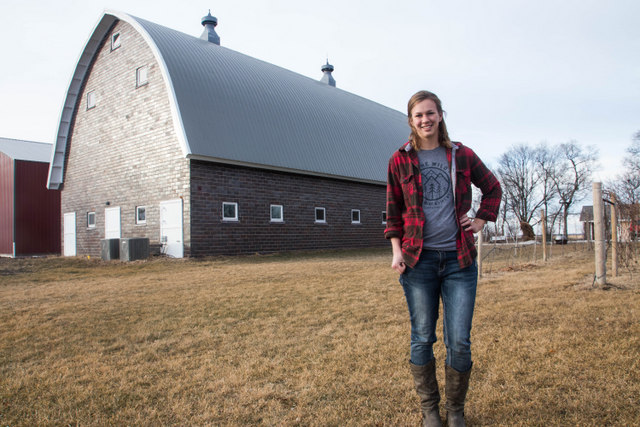
Events Spark Stories That Help Backcountry Winery Grow in Iowa
Ask Amber Gable about the back story behind Backcountry Winery at her family’s home east of Stratford, and her answer is straightforward. “It’s a hobby out of control.”
That hobby has taken Gable and her husband, Preston, on dynamic journey that has led to the creation of a small business that’s helping spur economic development in rural Iowa. At the heart of it all is a century-old barn that’s central to the story, offering an attractive venue for gatherings, celebrations, music concerts and more.
“This barn is such a unique building,” said Amber Gable, 27, who grew up on a farm near Sibley. “There’s so much history here, including original interior boards that have Stratford Grain and Supply stamped on them.”
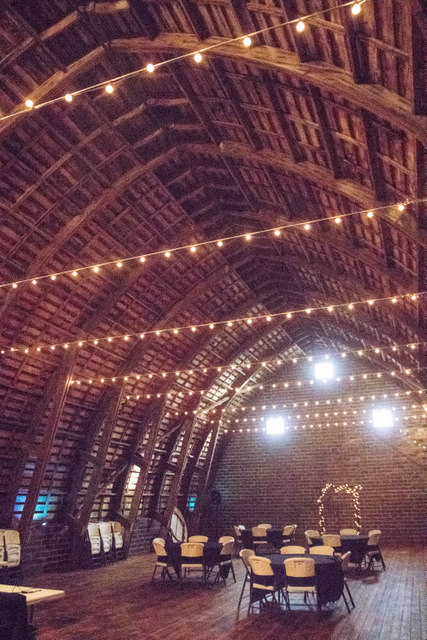
Beyond the tasting room on the main floor, the barn loft holds 150 people.
Guests who come to Backcountry Winery for bridal showers, wedding receptions, class reunions and other celebrations enjoy exploring this rural heritage. So do the visitors who stop by for Backcountry Winery’s live music events.
“When we’re open on Saturday afternoons without a special event like live music, we tend to have smaller crowds,” Gable said. “Events help create experiences that people seek out.”
Events of all types have become an increasingly important part of running a successful winery, noted Mike White, a viticulture specialist for Iowa State University Extension. “More wineries are realizing that there’s big potential in event centers, and many are going this way.”
Putting down roots in Hamilton County
For many guests, part of the experience involves learning the story of the winery. In the case of Backcountry Winery, that story began with Preston Gable’s long-time interest in home winemaking.
“We’d talk about how we might open a winery someday,” said Amber Gable, whose husband is a fellow northwest Iowa native from Hartley.
“Someday” seemed far off, however, when the high school sweethearts started their careers in Ames following their graduation from Iowa State University (ISU). Amber Gable became a landscape designer for an engineering firm, while her husband worked in biofuels research at ISU.
When the couple began looking for an affordable acreage in central Iowa where they could establish a home, start a family and maybe operate a winery eventually, the process became frustrating at times. “We actively looked for about a year and often came up with nothing,” Amber Gable said. “There were some tears along the way.”
Things turned around in 2014, though, when the young couple found an acreage with a house and barn northeast of Stratford. “We really needed a fixer-upper, and this place needed a family to put down roots,” Amber Gable said.
After the couple purchased the property in August 2014, they began remodeling the barn within a few months and exploring its history. The abstract for the property goes back to 1920, when the current home on the acreage was built by Alfred Erickson. “We know the barn pre-dates 1920, although we don’t know exactly when it was built,” Amber Gable said.
While the barn is structurally sound, time had taken a toll on some parts of the building. “We poured a new concrete floor and replaced the entire hayloft floor,” said Amber Gable, who noted that the barn once housed cattle.
After months of work, the Gables opened Backcountry Winery in May 2016. “The barn is still a work in progress, but it has allowed us to open our winery sooner than we anticipated,” said Amber Gable, who appreciates the opportunity to run a home-based business, especially now that she and her husband are raising their 1-year-old son, Ivan.
Word-of-mouth marketing, Backcountry Winery’s website and a Facebook page have helped the couple’s business grow. While Backcountry Winery hosted one wedding in 2016, this grew to five weddings in 2017 and has increased to seven weddings slated for 2018.
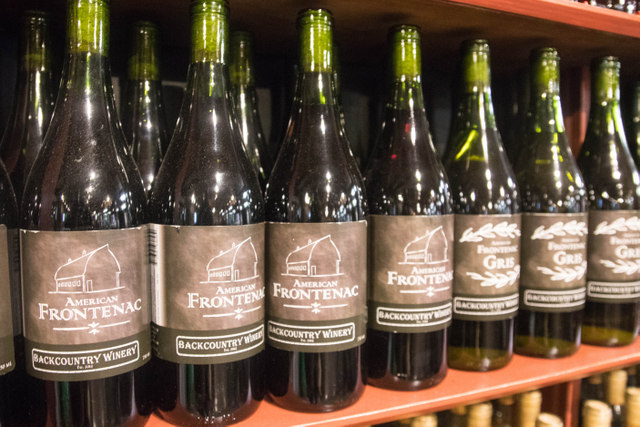
At Backcountry Winery, the Gables grow six varieties of wine grapes. They make 12 different wines, including strawberry, raspberry, cherry and apple wines, and plan to expand to 14 wines soon.
The Gables have invested in an expansion near the barn to accommodate these events. A connecting space on the west side of the barn will include a room when brides can get ready for their wedding. This connecting space is attached to a 60-foot by 90-foot addition that will provide additional production space, storage space and office space for the winery.
This infrastructure is just one part of Backcountry Winery’s recent expansions. While the Gables maintain a vineyard on the east side of the barn, the couple also began leasing an established, 4-acre vineyard near Webster City in the spring of 2017.
“It’s exciting to raise more of our own grapes so we can produce estate wines, which are made from our own crop,” said Amber Gable, who is a member of the Iowa Wine Growers Association. “There’s a great deal of pride in that.”
Wine wins big at Iowa State Fair
This pride is reflected in the large, silver trophy that graces the barn at Backcountry Winery. When the Gables competed in the commercial wine competition at the 2017 Iowa State Fair, the judges selected Vignoles from Backcountry Winery for the top honor, the Governor’s Cup. Vignoles is a semi-dry white wine that boasts crisp flavors of tropical and citrus fruits and a clean finish.
Vignoles is just one of the wines available from Backcountry Winery, where the Gables grow six varieties of wine grapes. They make 12 different wines, including strawberry, raspberry, cherry and apple wines, and plan to expand to 14 wines soon.
Backcountry Winery’s products can be purchased at the winery or through the approximately 25 retailers in Hamilton County and central, northern and northwest Iowa that partner with Backcountry Winery.
Raising specialty crops like wine grapes and offering Iowa wines offer unique opportunities to boost economic development in rural Iowa, Amber Gable said. “When visitors come to our winery, they not only buy wine, but they buy fuel at the convenience store in Stratford, which is owned by the local co-op, and they can go to Stanhope to get a burger. It’s rewarding to promote the whole Hamilton County experience.”
The Gables hope to attract more guests to the area by offering more live music this summer at the winery. This builds on the success of the three performances offered in 2016 and the 10 shows offered in 2017. The 2018 concerts, which range from country to classic rock, cost $5 for admission and will be held on certain Saturdays from 6 p.m. to 8 p.m. in the barn.
“Visiting a winery is all about the experience,” Amber Gable said. “We enjoy creating these memorable experiences, meeting people from across Iowa and beyond and promoting rural Iowa.”
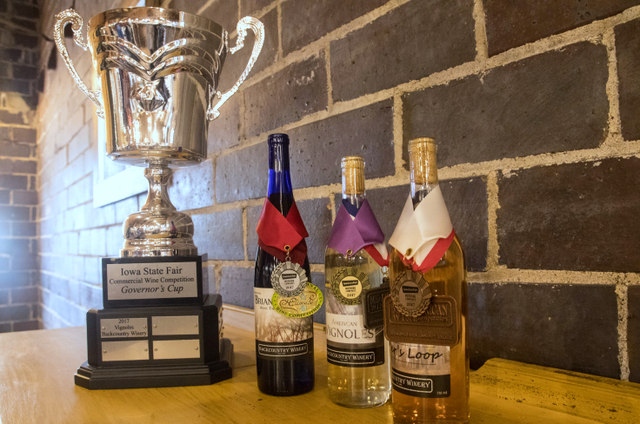
When the Gables competed in the commercial wine competition at the 2017 Iowa State Fair, the judges selected Vignoles from Backcountry Winery for the top honor, the Governor’s Cup. Vignoles is a semi-dry white wine that boasts crisp flavors of tropical and citrus fruits and a clean finish.
Iowa’s Wine Industry, By the Numbers
Data from the Iowa Wine Growers Association (IWGA) shows that Iowa has:
• 103 wineries
• 267 vineyards
• 1,300 acres of grapes
• 8 wine trails
• 40+ cold-climate grapes grown
• $420 million of economic impact in 2012
• 2,600 full-time jobs
• 358,000 wine related tourists per year
On average, the typical Iowa winery produces approximately 3,000 gallons of wine annually. The Iowa native wine industry helps promote and establish additional activity in the state, including lodging, food, travel, gifts, agri-tourism, event centers, festivals, music, art and a host of service industries.
“By our estimation, based on direct feedback from the wineries we surveyed, there was over $2.1 million in revenue generated from these wine-related events and facilities,” according to the 2012 “Economic Impact of Iowa Wine and Wine Grapes” report produced by Frank, Rimerman + Co, LLP.
In order for the industry to keep growing and attracting new visitors, wineries not only need to continue focusing on improving wine quality, but consider expanding into more wine-related events like private parties, weddings and festivals held on winery properties, according to the report.
- I originally wrote this story for the Progress section of Farm News, Ft. Dodge, Iowa in February 2018.
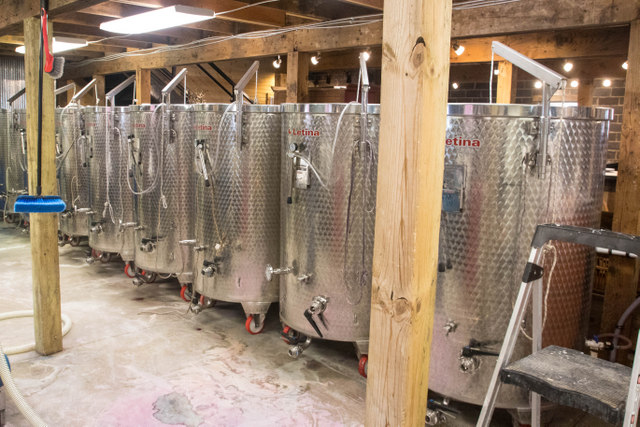
Backcountry Winery’s fermenting equipment is housed in a Hamilton County, Iowa, barn that’s approximately 100 years old.
Want more?
Thanks for stopping by. I invite you to read more of my blog posts if you value intriguing Iowa stories and history, along with Iowa food, agriculture updates, recipes and tips to make you a better communicator.
If you like what you see and want to be notified when I post new stories, be sure to click on the “subscribe to blog updates/newsletter” button at the top of this page, or click here. Feel free to share this with friends and colleagues who might be interested, too.
Also, if you or someone you know could use my writing services (I’m not only Iowa’s storyteller, but a professionally-trained journalist with 20 years of experience), let’s talk. I work with businesses and organizations within Iowa and across the country to unleash the power of great storytelling to define their brand and connect with their audience through clear, compelling blog posts, articles, news releases, feature stories, newsletter articles, social media, video scripts, and photography. Learn more at www.darcymaulsby.com, or e-mail me at yettergirl@yahoo.com.
If you’re hungry for more stories of Iowa history, check out my top-selling “Culinary History of Iowa: Sweet Corn, Pork Tenderloins, Maid-Rites and More” book from The History Press. Also take a look at my latest book, “Dallas County,” and my Calhoun County” book from Arcadia Publishing. Both are filled with vintage photos and compelling stories that showcase he history of small-town and rural Iowa. Order your signed copies today! Iowa postcards are available in my online store, too.
Let’s stay in touch. I’m at darcy@darcymaulsby.com, and yettergirl@yahoo.com.
Talk to you soon!
Darcy
@Copyright 2018 Darcy Maulsby & Co. Blog posts may only be reprinted with permission from Darcy Maulsby.

Tell Your Story—But How?
You hear it everywhere these days. “You’ve got to tell your story,” you’re told, whether you’re a farmer, a business professional or you’re someone trying to get your message across to your local or federal lawmaker.
It’s a refrain Sen. Joni Ernst emphasized when she spoke at the 2017 Iowa Ag Summit in Des Moines in August. “I know I always say, ‘Tell me your stories,’ but they are essential as we create the next Farm Bill,” she said. “I can share your stories with others on the Senate Ag Committee, especially those who are far removed from rural America.”
“Tell your story” also popped up again when I interviewed Brad Greenway, a South Dakota pork producer and 2016 America’s Pig Farmer of the Year. Created by the National Pork Board, this program honors a U.S. pork producer who excels at raising pigs using the We Care ethical principles and is committed to sharing his or her farming story with the American public.
“If we don’t share our stories, who will?” asked Greenway, who has traveled from Stanford University to Vienna, Austria, to speak to influential audiences about modern agriculture from the farmer’s point of view. It’s a perspective that’s not often heard, yet it’s essential, as Greenway and Ernst know.
So this begs the question—HOW do you tell your story? Storytelling is a role that can feel a little—or a lot—unsettling when you’re much more comfortable driving a tractor, raising livestock or growing crops.
As someone who knows farming and has worked as a professional communicator for 20 years, here are my top 5 storytelling tips to get you started:
1. Become a story detective. It’s amazing how many people I’ve interviewed through the years who don’t think they have an interesting story. That’s when I take off my farmer cap and put on my “detective cap” to dig a little deeper. Then I find out you own 30 restored Farmall tractors and love to go on tractor rides. Perhaps I learn you’ve mastered your mom’s molasses cookie recipe and have the blue ribbon to prove it. Or maybe I discover that you’re an avid learner when it comes to conservation practices on your farm, or you have a first-hand knowledge of why crop insurance is so important. All these things are interesting to others, trust me. They are also potential stories.
2. Know your audience. So you’ve identified some things that are important to you. Now the big question becomes, “What’s important to my audience?” The answer is vital to how you present your story. When I write an article for Farm News, I start by visualizing a farmer I know who might be interested in the topic and think, “What information can I share that would be most valuable to Bill?”
3. Learn how to listen. Knowing your audience is only possible when you listen to their needs, wants, concerns and aspirations. Ask plenty of questions, and truly listen to the answers. Put on your detective cap one more time to uncover the common ground you share with your audience. Then you’ll be better prepared to present your story in a way that resonates with your audience.
4. Pay attention to detail. Always be concise, since fewer words tend to deliver more power. Yet share enough relevant details (from the sights, sounds and smells to the emotions the topic stirs in you) to make your story come alive. Great storytelling is as much art as a science. Study the methods of people you encounter who are good storytellers, learn from them and keep practicing.
5. Don’t stop. Sharing your story isn’t a once-and-done. It’s an ongoing process, but the payoff is worth it. Keep at it, and you can become a trusted voice who provides a valuable resource for people (sometimes very powerful, influential people) who want to hear your stories. Like Brad Greenway said, if those of us in agriculture don’t share our stories, who will? I think we all know how that story goes.
By the way, if you want more storytelling tips or would like to share your own stories with me, I’d love to hear from you.
Want more?
Thanks for stopping by. I invite you to read more of my blog posts if you want more more intriguing Iowa stories and history, along with Iowa food, recipes and tips to make you a better communicator.
If you like what you see and want to be notified when I post new stories, be sure to click on the “subscribe to blog updates/newsletter” button at the top of this page. Feel free to share this information with friends and colleagues who might be interested, too.
If you’re hungry for more stories of Iowa history, check out my top-selling “Culinary History of Iowa: Sweet Corn, Pork Tenderloins, Maid-Rites and More” book from The History Press, as well as my Calhoun County” book from Arcadia Publishing, which showcases the history of small-town and rural Iowa. Order your signed copies today! Iowa postcards are available in my online store, too.
Let’s stay in touch. I’m at darcy@darcymaulsby.com, and yettergirl@yahoo.com.
P.S. Thanks for joining me. I’m glad you’re here.
@Copyright 2017 Darcy Maulsby & Co.
About me:
Some people know me as Darcy Dougherty Maulsby, while others call me Yettergirl. I grew up on a Century Farm
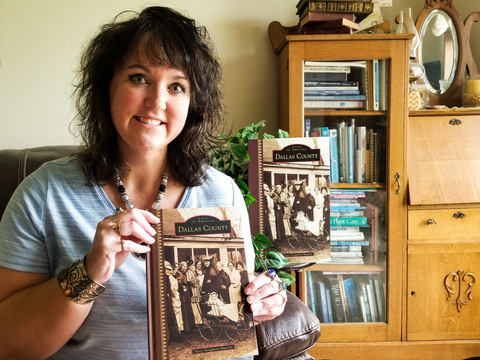
The Hotel Pattee and I are Hosting a Party—And You’re Invited!
What are you doing on Monday evening, Sept. 11? I would like to personally invite you to Perry to the historic Hotel Pattee at 7 p.m. for the debut of Dallas County, my latest non-fiction Iowa history book. It’s all here—drama, crime (Bonnie and Clyde), politics (Dallas County made President Harry Truman the original Comeback Kid), romance, tragedy, mystery, action, adventure, sports, food, agriculture, architecture, science, business, biography, comics and more—all told through more than 100 vintage photos and short stories in 10 chapters.
During this fun event at the hotel (click here for all the details!), I’ll take you on a time-traveling virtual tour of fun, surprising and sometimes shocking Dallas County history highlights. Stick around for the book signing after the program, and then stroll through the iconic Hotel Pattee to tour some of the guest rooms that will be open that evening. Every room in this grand boutique hotel features unique décor that tells the stories of Perry, Dallas County and Iowa history.
I’ve specifically asked that the luxurious Louis Armstrong Suite be open that evening. (In case you’re wondering about the Iowa connection, Louis Armstrong performed in Dallas County in 1954 at the legendary Lake Robbins Ballroom near Woodward and stayed at the Hotel Pattee.)
If nothing else, stop by on Sept. 11 for the homemade cookies the Hotel Pattee’s culinary team is preparing with some of my favorite recipes!
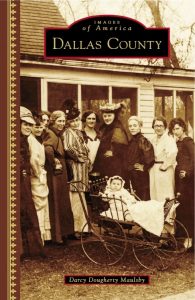 Explore forgotten Iowa history
Explore forgotten Iowa history
I am so excited to bring you this new hardcover, illustrated book, which is the first in-depth, non-fiction history of Dallas County, Iowa, in nearly 80 years!
No Iowa county has influenced American history more than Dallas County. It propelled Harry Truman to an unlikely victory in the 1948 presidential campaign, following a fiery speech he delivered to 100,000 farmers on a sweltering September day at the National Plowing Match near Dexter. Just 15 years earlier, a shoot-out near Dexfield Park marked the beginning of the end for infamous outlaws Bonnie and Clyde and the notorious Barrow Gang.
Dallas County, located just west of Des Moines, has produced several major-league baseball players (among them Bob Feller and Hal Manders), a US congressman (David Young), and Nile Kinnick, the 1939 Heisman Trophy winner and University of Iowa football legend whose grandfather George Clarke, of Adel, served as Iowa’s governor from 1913 to 1917.
Today, Dallas County is one of the fastest-growing counties in America and remains a region of opportunity with a rich heritage of small-town living, farming, coal mining, and the immigrant experience.
My 128-page book from Arcadia Publishing (order signed copies here) is filled with intriguing black-and-white, vintage photos on nearly every page, along with stories from Adel, Perry, Waukee, Granger, Woodward, Dexter, Linden, Minburn, Dawson, Dallas Center, Van Meter, Redfield, Bouton, surrounding rural areas and ghost towns.
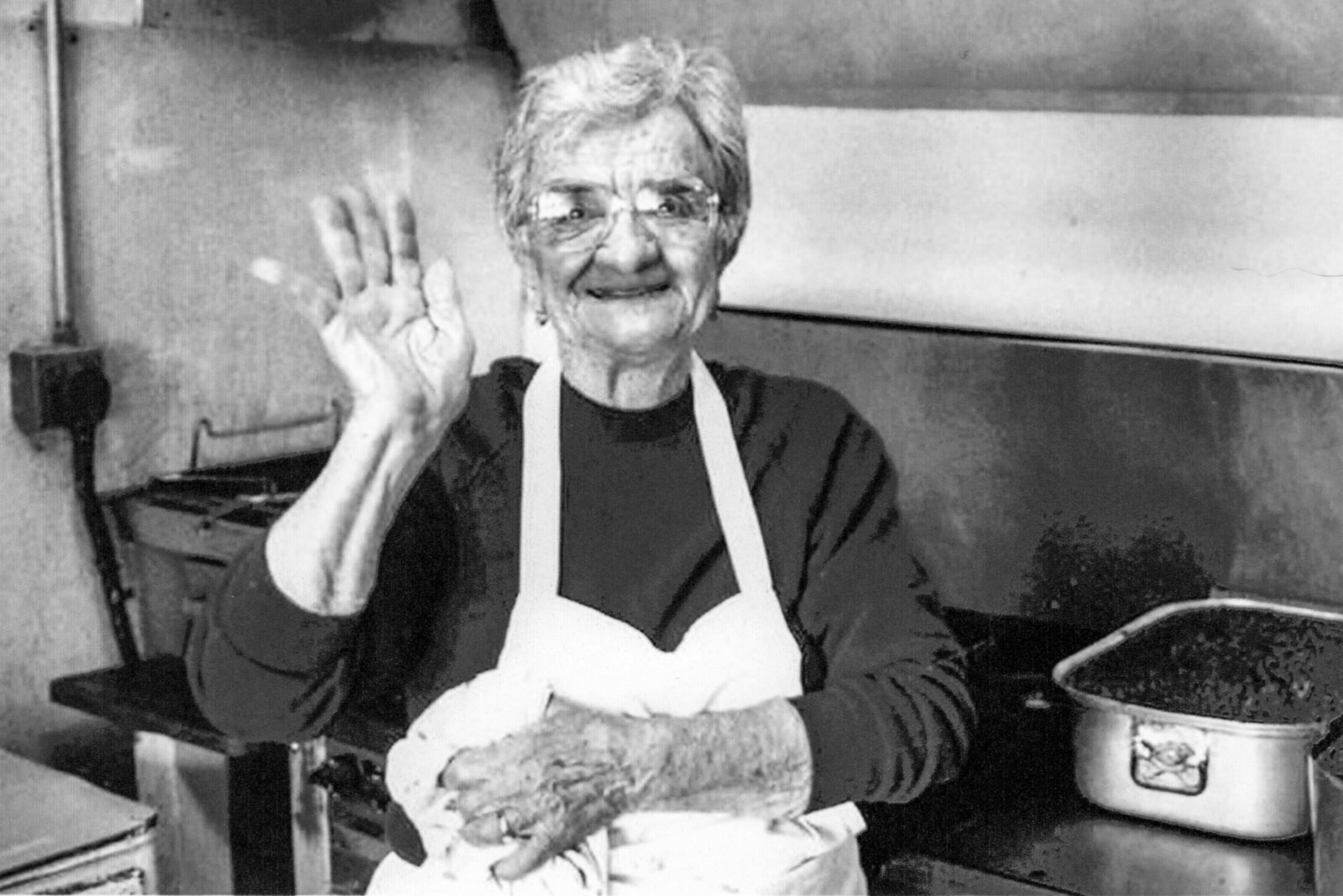
Alice Nizzi, owner of Alice’s Spaghettiland, an Italian restaurant open from 1947 – 2004 in Waukee. Source: Waukee Area Historical Society
Here’s a quick list of highlights that make this Dallas County book unique:
1. Many of the images have been donated from private collections.
2. In the early 20th century, Dallas County was one of the biggest coal-mining areas of Iowa. Much of this history, from Waukee to Woodward, is shared in this new Dallas County book. You can also get the inside story in this guest blog post I wrote for Hometown Heritage in Perry.
3. At least two circuses once made Dallas County their home base, including the famous Orton Bros. three-ring circus, where Five generations of the Orton family thrilled audiences for years. The Yankee Robinson Show, a Midwestern traveling circus, made its winter quarters two miles southeast of Granger. The spacious area also provided a place to bury deceased circus elephants. Granger may be the only Iowa town to claim an elephant graveyard.
4. Minburn’s legendary Singing Wheels roller skating show debuted in 1950 and ran through the early 1960s. Local children, high school students from the Minburn Roller Club and adults all participated in the Singing Wheels’ summer performances, which included a new theme every year, eye-catching costumes, and choreographed routines. These shows attracted thousands of people to the Minburn roller skating rink.
5. The Lake Robbins Ballroom, which opened on November 11, 1931, near Woodward, is still a popular entertainment destination and is one of the few remaining ballrooms in Iowa. The legendary Louis Armstrong performed at Lake Robbins in 1954 and stayed at the Hotel Pattee in Perry, where the most luxurious suite in the hotel is named in his honor.
6. Granger became the focal point of a successful New Deal program inspired by Monsignor Luigi Ligutti, who had served Assumption Church in Granger since 1926. Ligutti felt coal camps were an unsuitable environment for children and looked to the land to address the miners’ economic and social challenges. The 225-acre Granger Homesteads, built in 1935, included 50 modern homes, along with approximately four acres each for raising crops and livestock. In 1936, First Lady Eleanor Roosevelt visited the Granger Homesteads and praised the success of the project.
7. The KKK was active in Dallas County, especially Perry, in the early 1920s. Almost 15,000 people witnessed a KKK parade and semi-public meeting in Perry on May 31, 1924.
8. Dallas County is one of the fastest-growing counties in America and remains a region of opportunity with a rich heritage of small-town living, farming, coal mining, and the immigrant experience.
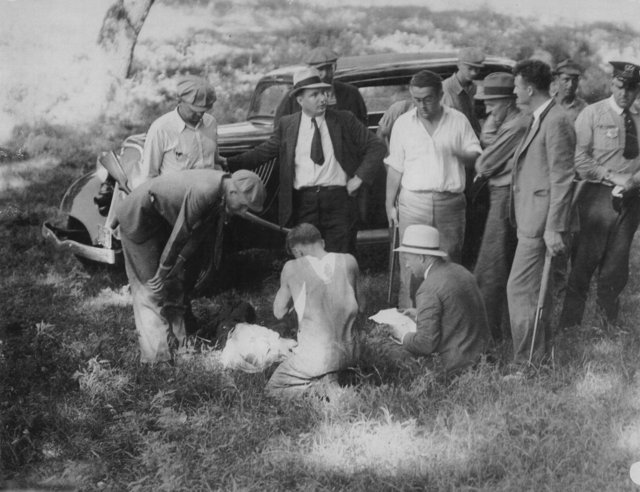
While Bonnie and Clyde escaped, Clyde’s older brother, Buck Barrow (shown lying on the ground), was mortally wounded during a shootout with law enforcement during the early morning hours of July 24, 1933, near Dexfield Park in southern Dallas County. Buck would die a few days later at Kings Daughters Hospital in Perry. Source: Dexter Museum
Click here to order your signed copy today! Priceless memories of Iowa history make a great gift, too.
• Series: Images of America
• Hardcover: 128 pages
• Publisher: Arcadia Publishing (September 4, 2017)
Want more?
Thanks for stopping by. I invite you to read more of my blog posts if you want more more intriguing Iowa stories and history, along with Iowa food, recipes and tips to make you a better communicator.
If you like what you see and want to be notified when I post new stories, be sure to click on the “subscribe to blog updates/newsletter” button at the top of this page. Feel free to share this information with friends and colleagues who might be interested, too.
If you’re hungry for more stories of Iowa history, check out my top-selling “Culinary History of Iowa: Sweet Corn, Pork Tenderloins, Maid-Rites and More” book from The History Press, as well as my Calhoun County” book from Arcadia Publishing, which showcases the history of small-town and rural Iowa. Order your signed copies today! Iowa postcards are available in my online store, too.
Let’s stay in touch. I’m at darcy@darcymaulsby.com, and yettergirl@yahoo.com.
About me:
Some people know me as Darcy Dougherty Maulsby, while others call me Yettergirl. I grew up on a Century Farm between Lake City and Yetter and am proud to call Calhoun County, Iowa, home. I’m an author, writer, marketer, business owner and entrepreneur who specializes in agriculture. Learn more at www.darcymaulsby.com.
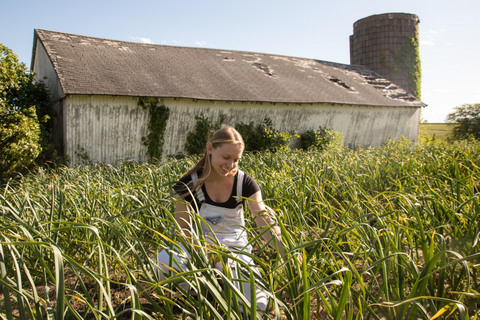
Ultra-Local Eating: Jennifer Miller Guides CSA, Iowa Food Cooperative
Jennifer Miller could hardly believe the question. “When will your bananas be ready?” inquired a central Iowa woman who was buying fresh produce through Miller’s Clarion Sage market garden and community supported agriculture (CSA) business near Waukee.
“People are disconnected from where their food comes from,” said Miller, 30, who noted the woman seeking locally-grown bananas is a well-educated business professional. “I’ve even had people look at our heirloom tomatoes and say, ‘I don’t want those,’ because they think they are GMOs.’”
This disconnect isn’t all that foreign to Miller, who grew up in Highland Park, Illinois, a northern suburb of Chicago. “I had no contact with agriculture in Highland Park,” said Miller, who serves as the Iowa Food Cooperative’s member services coordinator.
Miller did have a connection with Iowa, though, through her paternal grandparents, who lived in the Clarion/Rowan area. Her decision to move to Iowa in 2010 was spurred, in part, by a health challenge and new-found passion for healthy eating.
Miller was diagnosed a number of years ago with celiac disease, a serious autoimmune disorder where consuming gluten can damage the small intestine. “I started caring more about cooking and healthy recipes, because I just wanted to feel better,” said Miller, whose gluten-free and vegan recipes on her blog caught the attention of Martha Stewart Living editors, who invited her to develop recipes for them. “That’s what got me into food and agriculture.”
Food can be so much more interesting
After moving to Iowa, Miller got involved with community gardens in the Des Moines area and became a marketing/communications specialist Iowa Food Cooperative, which operates like an online farmers market. In 2013, Miller and her partner, Cody Kilgore, moved to an acreage on the southwest edge of Waukee’s city limits in Van Meter Township so they could operate their own farm.
“It felt like coming full circle,” said Kilgore, who was raised in rural Missouri, worked in the corporate world for nearly 30 years and was ready for a career switch.
 The couple planted garlic in the fall of 2013 to start their Clarion Sage market garden. The goal? “We believe in ultra-local and want to feed the community around us,” said Miller, who noted that Clarion Sage primarily serves families within a five-mile radius in southern Dallas County.
The couple planted garlic in the fall of 2013 to start their Clarion Sage market garden. The goal? “We believe in ultra-local and want to feed the community around us,” said Miller, who noted that Clarion Sage primarily serves families within a five-mile radius in southern Dallas County.
Today, Miller and Kilgore raise a wide array of vegetables and herbs, including lettuce, squash, cabbage, carrots, garlic, tomatoes, cucumbers, peppers, potatoes and more, including heirloom varieties that can’t be found in most stores. They offer an online ordering system for added convenience.
“Food can be so much more interesting,” Miller said. “Whether you’re sharing a family meal, providing snacks for your kids or making a favorite recipe, one thing’s for sure: the starting point for all these is good food.”
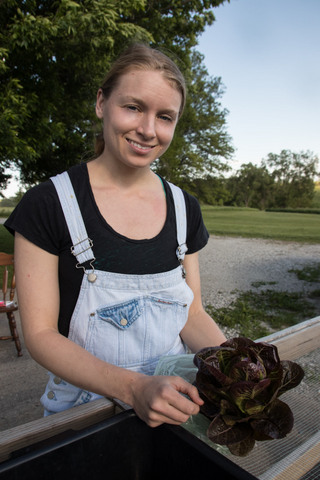
Jennifer Miller displays one of the unique lettuce varieties she grows at Clarion Sage Farm near Waukee.
Six lessons learned about farming and food
As their business evolved, Miller and Kilgore have adjusted their marketing plan to adapt to the often surprising—and sometimes frustrating—buying patterns they’ve observed in the market. The Clarion Sage market garden and CSA have taught them six key lessons, including:
1. Farming is more than production. Raising an abundant crop is just step one, said Miller, who has learned that that marketing and sales are equally important.
2. Mentors matter. “I didn’t grow up gardening, so working for various produce growers in Iowa and beyond taught me so much,” said Miller, who is grateful for leaders like Angela Tedesco who started Turtle Farm near Granger, Jill Beebout from Blue Gate Farm near Chariton and other local food proponents who have mentored her along the way.
3. Buying local adds flavor to life. Clarion Sage’s customers appreciate the “know your farmer” philosophy. Most buyers tend to be in their 30s and 40s with families, or they’re retired and have an interest in good food and time to cook. “Every week we offer our customers about $30 worth of fresh vegetables,” Miller said. “We focus on staple items like lettuce, potatoes, carrots and tomatoes, with the opportunity for more exotic options like stir-fry greens, kale and eggplant.”
4. Catering to consumers can be tricky. While the Clarion Sage CSA is right on Waukee’s doorstep, some consumers don’t want to drive to the farm to pick up vegetables. Some feel they don’t have time, while others don’t like the way the gravel road makes their vehicle dusty. When Miller tried offering delivery, some consumers still rejected this option, citing a lack of time or interest in preparing fresh food. Even full-color newsletters filled with cooking tips and recipes failed to gain much traction with these types of consumers, said Miller, who plans to start selling her produce at the Downtown Farmers’ Market in Des Moines.
5. Urban sprawl is relentless. High-density residential projects are planned for the area near the Clarion Sage’s market garden. “We’re in the bullseye of urban sprawl, which is a challenge,” said Kilgore, who also works as a wedding photographer.
6. Local food pairs well with global flavors. Miller loves ethnic cooking, from Latin American to African. “If you want to add more vegetables to your diet, look to other cultures that don’t have an abundance of meat protein,” said Miller, who encourages people to try vegetables like Cherokee Purple heirloom tomatoes (known for their smoky, complex flavor), fish peppers (which pack more heat), Merlot lettuce (whose dark red leaves offer a mellow flavor) and fingerling potatoes (which taste great fried or roasted).
Food is one of the best parts of life, added Miller, who loves the creativity involved in growing and marketing a crop. “You see a crop through from beginning to end, and you’re producing something that can feed and sustain people. That’s amazing to me.”
Want more?
Thanks for stopping by. I invite you to read more of my blog posts if you want more more intriguing Iowa stories and history, along with Iowa food, recipes and tips to make you a better communicator. If you like what you see and want to be notified when I post new stories, be sure to click on the “subscribe to blog updates/newsletter” button at the top of this page. Feel free to share this information with friends and colleagues who might be interested, too.
If you’re hungry for more stories of Iowa history, check out my top-selling “Culinary History of Iowa: Sweet Corn, Pork Tenderloins, Maid-Rites and More” book from The History Press, as well as my Calhoun County” book from Arcadia Publishing, which showcases the history of small-town and rural Iowa. Order your signed copies today! Iowa postcards are available in my online store, too.
Let’s stay in touch. I’m at darcy@darcymaulsby.com, and yettergirl@yahoo.com.
P.S. Thanks for joining me. I’m glad you’re here.
@Copyright 2017 Darcy Maulsby & Co.
About me:
Some people know me as Darcy Dougherty Maulsby, while others call me Yettergirl. I grew up on a Century Farm between Lake City and Yetter and am proud to call Calhoun County, Iowa, home. I’m an author, writer, marketer, business owner and entrepreneur who specializes in agriculture. Learn more at www.darcymaulsby.com.
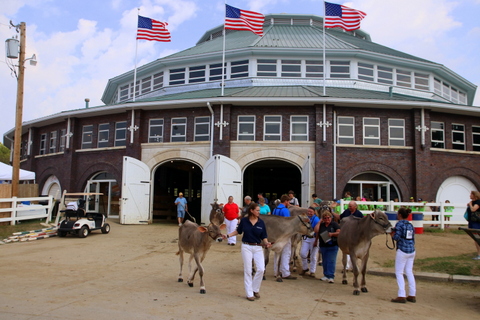
Iconic State Fair Architecture- Historic Buildings Reflect Decades of Memories
The Iowa State Fair is a homecoming for Iowans, and the historic buildings that grace the fairgrounds in Des Moines provide iconic venues for this statewide family reunion. There’s also a lot of surprising history behind many of these structures, from the Agriculture Building to the Livestock Pavilion.
“The Iowa State Fair connects generations of Iowans,” said Iowa Governor Kim Reynolds, who spoke during the opening ceremony of the 2017 Iowa State Fair on August 10. “There are so many wonderful memories and traditions here at the fair, which showcases the best of Iowa’s agricultural and cultural heritage.”
While the first Iowa State Fair was held October 25-27, 1854, in Fairfield, supported by a total operating budget of $323, the fair moved to its present location in 1886.
“The state fair moved to this site in Des Moines after the State Legislature and the City of Des Moines appropriated funds to purchase Calvin and Arminta Thornton’s farm,” said Leo Landis, state curator for the State Historical Society of Iowa, who helped lead an Iowa State Fair walking tour on Aug. 10. “One building original to the Thornton farm remains–Grandfather’s Barn, which is on the far eastern edge of the fairgrounds.”
Livestock Pavilion opened in 1902
Between the time the Fair Board purchased the land in June 1886 and when the fair opened in September 1886, crews constructed 67 buildings. “Of those, Pioneer Hall is the only one that remains today,” said Landis, museum curator at the State Historical Museum.
By the 1900 Iowa State Fair, most of the buildings built for the 1886 fair were still in use. They were beginning to show signs of decay, however, and roofs were particularly bad. It was time for the Iowa State Fair to clean up the fairgrounds.
One of the first new buildings added more than a century ago was the Livestock Pavilion. Back in 1901, more than 650 cattle were shown at the Iowa State Fair – only about 50 less than were shown that year at the International Stock Show at Chicago, Landis said. With future Iowa State Fairs expected to have even more cattle, the Iowa Legislature appropriated $37,000 for a fireproof steel-and-brick stock pavilion, similar to one that had just been constructed at the Illinois State Fairgrounds.
The Livestock Pavilion was the first major brick-and-steel structure built at the Iowa State Fairgrounds. “By constructing buildings out of these materials, the Fair Board gave the fair a sense of permanence and safety at this location,” said Landis, who noted that the new Livestock Pavilion officially opened for the 1902 fair and has been used for stock judging, lectures, entertainment and more for decades.
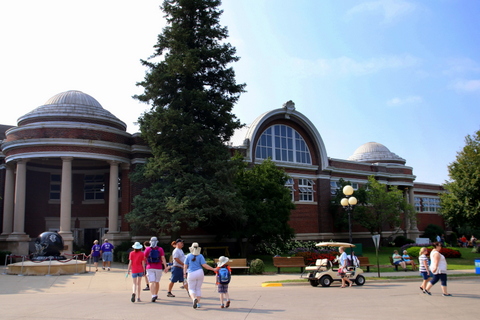
A new Agriculture Building was constructed in time for the 1904 Iowa State Fair. This famous building is home to the beloved Butter Cow. The Agriculture Building is one of the finest examples of Double Jeffersonian architecture remaining in the world.
1904 State Fair showcased new Agriculture Building
A new Agriculture Building came along two years later, in time for the 1904 Iowa State Fair. Located at the intersection of Grand Avenue and Rock Island Avenue, the Agriculture Building was built along the route to and from the State Fair from the Rock Island Railroad depot.
From the beginning, the Agriculture Building has been used as the agricultural, horticultural and dairy building. It’s home to the famous Butter Cow and other butter sculptures, which have been part of the Iowa State Fair since 1911.
“The Homestead,” a well-known farm newspaper of the late 1800s and early 1900s published in Des Moines, touted the new Agriculture Building as “one of the finest structures for exhibiting products of the farm that can be found in the Central West.”
The building’s design was inspired by the Exposition Halls at the Columbian Exposition, the world’s fair held in Chicago in 1893. The Agriculture Building is one of the finest examples of Double Jeffersonian architecture remaining in the world.
“Building a structure of such grand scale – with 33,800 square feet of floor space – suggested to visitors that the Iowa State Fair was an event of both civic and social importance,” said Jessica Rundlett, special projects and outreach coordinator at State Historical Museum of Iowa, who assisted with the Iowa State Fair walking tour.
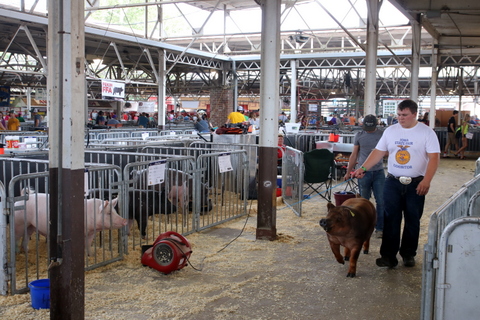
Kyle Andrews with the Wayne FFA chapter exhibited hogs during the 2017 Iowa State Fair. The Swine Barn was built in 1907.
Swine Barn design enhanced ventilation
When a new Swine Barn was constructed for the 1907 Iowa State Fair, the roof covered 185,000 square feet of stalls, exhibition areas and two central show rings that could seat more than 800 people. “The Homestead newspaper said you had to see it to believe its grand size,” Landis said.
The state appropriated $75,000 to build the Swine Barn. The building’s roof profile is designed to provide superior lighting and ventilation. The long open windows at roof level and open exterior walls draw in fresh air. Today you can see the Big Boar at the Swine Barn, as well as the Avenue of Breeds, which is coordinated by the North Polk FFA.
Horse Barn cost $25,000
The Horse Barn was completed in 1912 for $25,000 and renovated in 1929. Measuring 156 feet by 224 feet, the new barn could accommodate 132 draft horses and a like number of ponies, according to the Homestead newspaper. Th article also noted the new barn was equipped with water troughs, wash stands, sanitary feed mangers and automatic hayracks, Landis said.
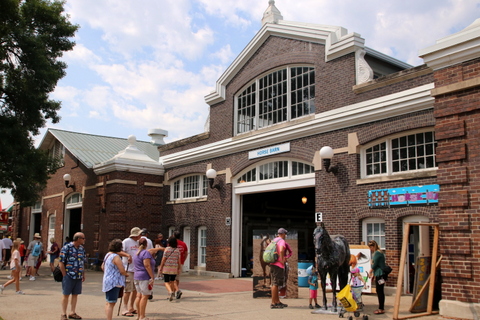
The Horse Barn was completed in 1912 for $25,000 and renovated in 1929.
Cattle Barn named for Iowa farmer
The Iowa State Fair’s building boom of the early twentieth century included the new Cattle Barn, which opened for the 1914 fair. While the original barn could accommodate 108 head of cattle, the barn now has ties for 1,600 cows, thanks to multiple expansions through the years.
Among the early proponents of Iowa’s cattle industry was Iowa Governor William Larrabee of Clermont, Landis noted. Larrabee helped introduced Brown Swiss dairy cattle to Iowa after studying the breed and concluding Brown Swiss were best suited for Iowa’s climate.
Today, the Cattle Barn is named for John Putney, a farmer from Gladbrook who was also a long-time cattle exhibitor, president of the Sale of Champions and beef superintendent. Putney was appointed the first executive director of the Blue Ribbon Foundation, which has raised more than $135 million in the last 25 years to renovate and preserve the Iowa State Fairgrounds.
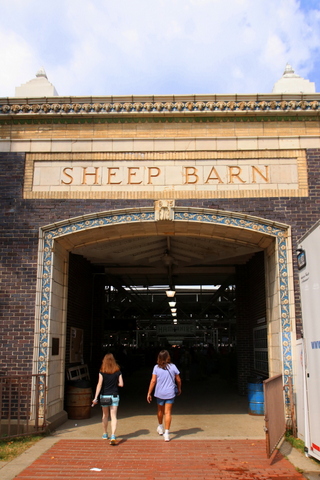
In 1915, the state legislature appropriated $14,000 to build a sheep pavilion. The Sheep Barn opened for the 1917 Iowa State Fair. The building is notable for the detailed terra cotta designs on the east façade, including a row of rams’ heads near the roof.
Sheep Pavilion opened for 1917 fair
During the Golden Age of Agriculture, state funding was available to construct a wide range of livestock barns at the Iowa State Fair. In 1915, the state legislature appropriated $14,000 to build a sheep pavilion. The Sheep Barn opened for the 1917 Iowa State Fair. The building is notable for the detailed terra cotta designs on the east façade, including a row of rams’ heads near the roof.
The legacy lives on
The Iowa State Fairgrounds was listed on the National Register of Historic Places in 1987. It’s a fitting honor for a unique venue filled with many architectural marvels. “The late Bill Wagner, a preservation architect from Iowa, noted that ‘the complex contains a representative collection of almost all architectural styles for most of the past 200 years,’” Landis said.
Historic buildings are just one of the many reasons the Iowa State Fair is the best state fair in the nation, Reynolds said. “I’m extraordinarily proud of this tradition. Remember—nothing compares to our great Iowa State Fair!”
Take a virtual tour
The Iowa State Fair Walking Tour can be found on the Iowa Culture App. Either download the app, or log onto dcaapp.com. Click on the featured tour “Star” button on the right and look for the “Iowa State Fair tour.”
Want more?
Thanks for stopping by. I invite you to read more of my blog posts if you want more more intriguing Iowa stories and history, along with Iowa food, recipes and tips to make you a better communicator. If you like what you see and want to be notified when I post new stories, be sure to click on the “subscribe to blog updates/newsletter” button at the top of this page. Feel free to share this information with friends and colleagues who might be interested, too.
If you’re hungry for more stories of Iowa history, check out my top-selling “Culinary History of Iowa: Sweet Corn, Pork Tenderloins, Maid-Rites and More” book from The History Press, as well as my Calhoun County” book from Arcadia Publishing, which showcases the history of small-town and rural Iowa. Order your signed copies today! Iowa postcards are available in my online store, too.
Let’s stay in touch. I’m at darcy@darcymaulsby.com, and yettergirl@yahoo.com.
P.S. Thanks for joining me. I’m glad you’re here.
@Copyright 2017 Darcy Maulsby & Co.
About me:
Some people know me as Darcy Dougherty Maulsby, while others call me Yettergirl. I grew up on a Century Farm between Lake City and Yetter and am proud to call Calhoun County, Iowa, home. I’m an author, writer, marketer, business owner and entrepreneur who specializes in agriculture. Learn more at www.darcymaulsby.com.


